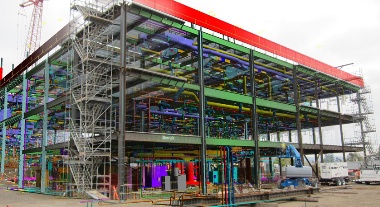
At some point every designer comes under pressure to trim costs or compromise. Ruth Slavid looks at how three practitioners resist moves that, however well intentioned, can turn a great design into a mediocre one
All lighting designers know that the best lighting design in the world can be ruined in execution. If the contractor switches to supposed equivalents which are cheaper or easier to access and install – and don't have the same effect at all – the results can be disastrous.
So it struck a chord with us when US-based lighting designer James Bedell posted a blog on his site entitled 'Three Ways to Fight Mediocrity in Lighting Design'.
"You can have the greatest concept in the world," says Bedell in the blog. "Nevertheless, somewhere along the way your project will hit a rough patch. Resistance will creep in and you have no choice but to fight through it or succumb to mediocrity."
Beddell defines 'resistance' as "all of the things that other members of the team will use to try and reduce the initial design down to something they are more comfortable with, or that's less expensive."
Some of the most typical objections he comes up against include: 'The gear he wants is much more expensive', 'Does it really matter if we use that light?' and 'This seems more complicated than it needs to be'.
Bedell's work is largely in the US residential sector but, whatever the environment, he says it is unwise to bash the electrical contractor. "Appeal to their sense of professionalism," he advises. "Contractors are used to getting treated poorly. Clients and designers are terrible about respecting the quality of work good craftspeople and contractors do.
"Contractors usually care about their work and so when they are asking for simpler design details what they are really asking for is something they are sure they can do right."
On this side of the Atlantic and at different scales of work, the details of the problem may be different. But the need to defend specifications is the same and the responses, while nuanced, boil down to making sure the client is on side, and making the specification as watertight as possible.
To look at some of the ways in which the battle changes from sector to sector, we spoke to three UK-based designers to see how they cope with the spec busters.
Melanie Shaw, lighting designer, Brilliant Lighting. Industry area: Residential lighting

Like Bedell, Melanie Shaw of Brilliant Lighting works with domestic clients, and she believes that being involved early, staying with the job until the end and dealing with all the details is the answer.
"We design the lighting and lighting control systems, brief the electrical contractors and resolve queries on an ongoing basis, supply the fittings and control systems and commission it all," she says. "This level of involvement has mixed blessings. However much we love our clients and the project teams, two dozen calls a day can be a bit much sometimes!
"But on the plus side we are ideally placed to make sure the designs really do make it all the way through."
Keeping the client informed is vital, she believes. "We talk clients through the fittings we're specifying, essentially giving them reasons to feel good about the purchasing decisions that they're making," she says. "This gives them a quality benchmark against which to measure alternatives."
And, if at the end of the day hard decisions do have to be made to meet constrained budgets, Shaw says, "We advise them to focus the spend on the elements that really matter and cut out some of the 'nice to haves' instead."
Chris Boyce, architect, Capita Symonds. Industry area: Education and offices

Chris Boyce, an architect and a director at Capita Symonds, responsible for multi-disciplinary design, is working at a larger scale, but sees client buy-in as crucial there, too.
He is presently working on a number of schools and says: "Teachers don't understand, until you start enlightening them, about the huge contribution that lighting can make to the well-being of their students." Once you have got the message across, he believes, the chances of protecting your design have improved.
Much of Boyce's previous work was on offices, and he believes that extending methods used in high-end office design can be helpful in schools – in particular finding a space in which to create a mock-up so the client can see what the lighting will look like.
"We have actually done full-scale mock-ups of office environments," he says, "so that the end-user can fiddle with the fittings in a controllable light space."
He agrees that contractors will apply pressure to go with supply chain members with whom they have a good relationship – and who can help them get discounted prices. Only a highly informed client (informed by the design team) will be able to resist that pressure. This is where he believes that the much-maligned PFI can actually help a designer, since a good PFI funder should be interested in longevity and quality, rather than simply getting the lowest price.
David Mooney, lighting designer, Atkins. Industry area: Education, offices and public buildings

David Mooney, a lighting designer and associate at design and engineering consultancy Atkins, agrees that working with clients to protect product specification is key to guaranteeing quality and design intent.
"With the wide range of procurement processes now used in the construction industry, the designers are not necessarily involved throughout an entire project. "This means that designers' approaches to specification need to reflect the process used and may require more work than they currently undertake.
"If, for example, the designers are only involved in stages A to D, the specifications are passed directly to the contractor or to another design team, who may well look to simplify the design complexity with a view to reducing costs.
"It is essential that we work with the client to explain the benefits of the original design intent, while acknowledging the need for flexibility, before writing a watertight specification."
David Mooney, lighting designer
"It is, therefore, essential that we work with the client to explain the benefits of the original design intent, while acknowledging the need for flexibility, before writing a watertight specification."
Atkins' approach is to identify two or three manufacturers who can deliver the required product performance specified and write their names and products into the specification. Having been specified, manufacturers must react in a commercial manner with the contractor's supply chain, offering a good service.
Competition in the supply chain
Mooney adds: "We give contractors a choice of similarly performing products that allows the manufacturers to compete and the contractor to take a commercial approach while maintaining quality and value. There, will, however, always be times when a unique design feature will dictate a single specification."
Mooney also writes in his specifications that any changes that are proposed to the luminaire specification at tender stage must be supported by relevant calculations and evidence that the design intent is maintained.
The effect of late design changes can extend beyond changing luminaries. For example, if the finish of a concrete ceiling is changed from a smooth white 'snowcrete' finish to a more standard concrete, then the reflectance will change and, if an uplit scheme has been designed, then consequentially the level of luminance will fall. Similarly, if the height or depth of a classroom is altered, it may invalidate the designed daylighting solution.

Mooney believes BIM design methods will help designers protect their concepts
Mooney believes the future of specification will be tighter, due to the rise of Building Information Modelling (BIM) and stringent energy and performance criteria. The restrictions on substitutions will necessarily be more difficult due to the way that lighting will be tied into the overall building design.
Changes enacted later on in the contractual process may necessitate the reworking of quite large portions of the work to prove compliance with specifications and legislation once the information is written into the BIM model. Changes could mean recalculation of, for example, the LENI (Lighting Energy Numerical Index) calculations, which, it is hoped, will be a part of the New Part L of the Building Regulations.





